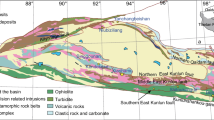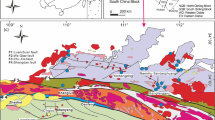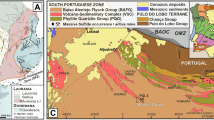Abstract
Eocene volcanic rocks with basaltic-trachyandesite and trachybasalt composition which cross-cut the Cretaceous sedimentary rocks, are exposed in the northwestern part of the Central-East Iranian Microcontient (CEIM) (SE of Khur, Isfahan Province, Iran). The rock-forming minerals of these volcanic rocks are olivine (chrysolite and hyalosiderite, Mg# = 0.69–0.71), clinopyroxene (augite with Mg# = 0.74–0.84), orthopyroxene (enstatite with Mg# = 0.61–0.62) and plagioclase (andesine and labradorite with An48.3-65.1). Phenocrysts set in a fine-grained matrix of the same minerals plus sanidine (Or59.1Ab36.6An4.3) with minor amounts of opaque minerals (magnetite and ilmenite). Secondary minerals are chlorite and calcite. The main textures of these volcanic rocks are porphyritic, microlitic porphyritic, poikilitic, and glomeroporphyritic. The Eocene volcanic rocks of the Khur area are characterized by SiO2 content of 51.8 to 54.9 wt %, Al2O3 amounts of 14.35 to 16.47 wt %, and TiO2 values of 0.88 to 0.92 wt %. They exhibit strong enrichment in light rare earth elements (LREE) relative to heavy REE (HREE) (La/Lu ratio up to 102.35), enrichment in large ion lithophile elements (LILEs), depletion in high field strength elements (HFSE), and present negative anomaly in Eu (Eu/Eu* = 0.72–0.87). Chemical characteristics and homogeneity of these volcanic rocks reveal their calc-alkaline nature and suggest that they were derived from a same parental magma and underwent a similar melt extraction. Major and trace elements geochemical features of the analyzed samples indicate that the parental magma was possibly derived from relatively low degrees of partial melting of a mantle wedge spinel lherzolite which was previously enriched by fluids/melts released from the Neo-Tethyan subducted slab.












Similar content being viewed by others
REFERENCES
Abdel-Rahman, A.F.M. and Nassar, P.E., Cenozoic volcanism in the Middle East: petrogenesis of alkali basalts from northern Lebanon, Geol. Mag., 2004, vol. 141, pp. 545–563.
Agard, P., Omrani, J., Jolivet, L., et al., Zagros orogeny: a subduction-dominated process, Geol. Mag., 2011, vol. 148, pp. 692–725.
Aistov, L., Melanikov, B., Krivyokin, B., et al., Geology of Khur Area (Central Iran), Geol. Surv. Iran, Tehran, Technoexport Report, 1984, no. 20, p. 132.
Bagheri, S. and Stampfli, G.M., The Anarak, Jandaq and Posht-e-Badam metamorphic complexes in Central Iran: new geological data, relationships and tectonic implications, Tectonophysics, 2008, vol. 451, pp. 123–155.
Beermann, O., Holtz, F., and Duesterhoeft, E., Magma storage conditions and differentiation of the mafic Lower Pollara volcanics, Salina Island, Aeolian Islands, Italy: implications for the formation conditions of shoshonites and potassic rocks, Contrib. Mineral. Petrol., 2017, vol. 172, pp. 1–21.
Defant, M.J. and Kepezhinskas, P., Evidence suggests slab melting in arc magmas, EOS, Trans. Amer. Geophys. Union., 2001, vol. 82, pp. 65–69.
Dehghani, G.A. and Makris, J., The gravity field and crustal structure of Iran, N. Jb. Geol. Paläont., 1984, vol. 168, pp. 215–229.
Dilek, Y., Imamverdiyev, N., and Altunkaynak, S., Geochemistry and tectonics of Cenozoic volcanism in the Lesser Caucasus (Azerbaijan) and the peri-Arabian region: collision-induced mantle dynamics and its magmatic fingerprint, Int. Geol. Rev., 2010, vol. 52, pp. 536–578.
Elliott, T., Tracers of the slab, Geophys. Monogr. Ser., 2003, vol. 138, pp. 23–46.
Ersoy, E.Y., Helvacı, C., and Palmer, M.R., Mantle source characteristics and melting models for the early-middle Miocene mafic volcanism in Western Anatolia: Implications for enrichment processes of mantle lithosphere and origin of K-rich volcanism in post-collisional settings, J. Volcanol. Geotherm. Res., 2010, vol. 198, pp. 112–128.
Ersoy, E.Y., Palmer, M.R., Genc, S.C., et al., Chemo-probe into the mantle origin of the NW Anatolia Eocene to Miocene volcanic rocks: Implications for the role of crustal accretion, subduction, slab roll-back and slab break-off processes in genesis of post-collisional magmatism, Lithos, 2017, vol. 288, pp. 55–71.
Femenias, O., Berza, T., Tatu, M., et al., Nature and significance of a Cambro–Ordovician high-K, calc-alkaline sub-volcanic suite: the late-to post-orogenic Motru Dyke Swarm (Southern Carpathians, Romania), Int. J. Earth Sci., 2008, vol. 97, pp. 479–496.
Foley, S.F. and Wheller, G.E., Parallels in the origin of the geochemical signatures of island arc volcanics and continental potassic igneous rocks: the role of residual titanates, Chem. Geol., 1990, vol. 85, pp. 1–18.
Francalanci, L. and Zellmer, G.F., Magma Genesis at the south Aegean volcanic arc, Elements, 2019, vol. 15, pp. 165–170.
Goli, Z., Torabi, G., and Arai, S., High-K calc-alkaline Eocene volcanic rocks from the Anarak area (Central Iran): a key structure for the early stages of oceanic basin closure and the beginning of collision, Geotectonics, 2021, vol. 55, pp. 1–18.
Gorton, M.P. and Schandl, E.S., From continents to island arcs: a geochemical index of tectonic setting for arc-related and within-plate felsic to intermediate volcanic rocks, Can. Mineral., 2000, vol. 38, pp. 1065–1073.
Gudnason, J., Holm, P.M., Soager, N., et al., Geochronology of the late Pliocene to recent volcanic activity in the Payenia back-arc volcanic province, Mendoza Argentina, J. S. Amer. Earth Sci., 2012, vol. 37, pp. 191–201.
Guo, Z., Cheng, Z., Zhang, M., et al., Post-collisional high-K calc-alkaline volcanism in Tengchong volcanic field, SE Tibet: constraints on Indian eastward subduction and slab detachment, J. Geol. Soc. London, 2015, vol. 172, pp. 624–640.
Harangi, S., Downes, H., Thirlwall, M., et al., Geochemistry, petrogenesis and geodynamic relationships of Miocene calc-alkaline volcanic rocks in the Western Carpathian arc, eastern central Europe, J. Petrol., 2007, vol. 48, pp. 2261–2287.
Hastie, A.R., Kerr, A.C., Pearce, J.A., et al., Classification of altered volcanic island arc rocks using immobile trace elements: development of the Th–Co discrimination diagram, J. Petrol., 2007, vol. 48, pp. 2341–2357.
Hirschmann, M.M., Asimow, P.D., Ghiorso, M.S., et al., Calculation of peridotite partial melting from thermodynamic models of minerals and melts. III. Controls on isobaric melt production and the effect of water on melt production, J. Petrol., 1999, vol. 40, pp. 831–851.
Hollocher, K., Robinson, P., Walsh, E., et al., Geochemistry of amphibolite-facies volcanics and gabbros of the Storen Nappe in extensions west and southwest of Trondheim, Western Gneiss Region, Norway: a key to correlations and paleotectonic settings, Amer. J. Sci., 2012, vol. 312, pp. 357–416.
Hou, T., Zhang, Z., Encarnacion, J., et al., Geochemistry of Late Mesozoic dioritic porphyries associated with Kiruna-style and stratabound carbonate-hosted Zhonggu iron ores, Middle-Lower Yangtze Valley, Eastern China: Constraints on petrogenesis and iron sources, Lithos, 2010, vol. 119, pp. 330–344.
Irvine, T.N. and Baragar, W.R.A., A guide to the chemical classification of the common volcanic rocks, Can. J. Earth Sci., 1971, vol. 8, pp. 523–548.
Jamshidzaei, A., Torabi, G., Morishita, T., et al., Eocene dike swarm and felsic stock in Central Iran: roles of metasomatized mantle wedge and Neo-Tethyan slab, J. Geodynam., 2021, vol. 145.
Jaques, A.L., Creaser, R.A., Ferguson, J., et al., A review of the alkaline rocks of Australia, S. Afr. J. Geol., 1985, vol. 88, pp. 311–334.
Kelemen, P.B., Hanghoj, H., and Greene, A.R., One view of the geochemistry of subduction- related magmatic arcs, with an emphasis on primitive andesite and lower crust, Treatise on Geochemistry, 2014, vol. 4, pp. 749–797.
Kiseeva, E.S., Kamenetsky, V.S., Yaxley, G.M., et al., Mantle melting versus mantle metasomatism - The chicken or the egg dilemma, Chem. Geol., 2017, vol. 455, pp. 120–130.
Li, W., Ge, C., Wang, F., et al., The spatial distribution characteristics of Nb–Ta of mafic rocks in subduction zones, Open Geosci., 2021, vol. 13, pp. 390–400.
Le Maitre, R.W., Streckeisen, A., Zanettin, B., et al., Igneous Rocks: a Classification and Glossary of Terms: Recommendations of the International Union of Geological Sciences Subcommission on the Systematics of Igneous Rocks, Cambridge: Cambridge University Press, 2005.
Maniar, P.D. and Piccoli, P.M., Tectonic discrimination of granitoids, Geol. Soc. Am. Bull., 1989, vol. 101, pp. 635–643.
McDonough, W.F. and Sun, S., The composition of the Earth, Chem. Geol., 1995, vol. 120, pp. 223–253.
Middlemost, E.A., Iron oxidation ratios, norms and the classification of volcanic rocks, Chem. Geol., 1989, vol. 77, pp. 19–26.
Mo, X., Hou, Z., Niu, Y., et al., Mantle contributions to crustal thickening during continental collision: evidence from Cenozoic igneous rocks in southern Tibet, Lithos, 2007, vol. 96, pp. 225–242.
Muller, D., Rock, N.M.S., and Groves, D.I., Geochemical discrimination between shoshonitic and potassic volcanic rocks in different tectonic settings: a pilot study, Mineral. Petrol., 1992, vol. 46 pp. 259–289.
Muller, D. and Groves, D., Potassic Igneous Rocks and Associated Gold–Copper Mineralization, New York: Springer, 2019.
Murphy, J., Igneous rock associations. Arc magmatism II: Geochemical and isotopic characteristics, Geosci. Can. Ser., 2007, vol. 34, pp. 7–35.
Nazari, G.H., Torabi, G., Arai, S., et al., Lower Oligocene calc-alkaline spessartitic lamprophyres from Central Iran (east of Anarak area): an evidence from the eastern branch of Neotethys subduction-related mantle enrichment, Geotectonics, 2019, vol. 53, pp. 786–805.
Nosouhian, N., Torabi, G., and Arai, S., Late Cretaceous dacitic dykes swarm from Central Iran, a trace for amphibolite melting in a subduction zone, Geotectonics, 2016, vol. 50, pp. 295–312.
Oyan, V., Keskin, M., Lebedev, V.A., et al., Petrology and geochemistry of the Quaternary mafic volcanism to the NE of Lake Van, Eastern Anatolian Collision Zone, Turkey, J. Petrol., 2017, vol. 58, pp. 1701–1728.
Pearce, J.A., Trace element characteristics of lavas from destructive plate boundaries, in Andesites: Orogenic Andesites and Related Rocks, Thorpe, T.S., Eds., Chichester: John Wiley and Sons, 1982.
Pirnia, T., Saccani, E., Torabi, G., et al., Cretaceous tectonic evolution of the Neo-Tethys in Central Iran: Evidence from petrology and age of the Nain-Ashin ophiolitic basalts, Geosci. Front., 2020, vol. 11, pp. 57–81.
Rajabi, S., Torabi, G., and Arai, S., Oligocene crustal xenolith-bearing alkaline basalt from Jandaq area (Central Iran): implications for magma genesis and crustal nature, Island Arc, 2014, vol. 23, pp. 125–141.
Remizov, D. and Pease, V., The Dzela complex, Polar Urals, Russia: A Neoproterozoic island arc, Geol. Soc. Lond. Mem., 2004, vol. 30, pp. 107–123.
Sargazi, M., Torabi, G., and Morishita, T., Petrological characteristics of the Middle Eocene Toveireh pluton (southwest of Jandaq, central Iran): Implications for the eastern branch of the Neo-Tethys subduction, Turk. J. Earth Sci., 2019, vol. 28, pp. 558–588.
Schmidt, M.W. and Jagoutz, O., The global systematics of primitive arc melts, Geochem. Geophys. Geosyst., 2017, vol. 18, pp. 2817–2854.
Sen, P.A., Temel, A., and Gourgaud, A., Petrogenetic modelling of Quaternary post-collisional volcanism: a case study of central and eastern Anatolia, Geol. Mag., 2004, vol. 141, pp. 81–98.
Shirdashtzadeh, N., Torabi, G., and Schaefer, B., A magmatic record of Neoproterozoic to Paleozoic convergence between Gondwana and Laurasia in the northwest margin of the Central-East Iranian Microcontinent, J. Asian Earth Sci., 2018, vol. 166, pp. 35–47.
Stocklin, J., Structural history and tectonics of Iran: A review, AAPG Bull., 1968, vol. 52, pp. 1229–1258.
Sun, S.S. and McDonough, W.F., Chemical and isotopic systematics of oceanic basalts: Implications for mantle composition and processes, Geol. Soc. Spec. Publ., 1989, vol. 42, pp. 313–345.
Tadayon, M., Rossetti, F., Zattin, M., et al., The long-term evolution of the Doruneh Fault region (Central Iran): A key to understanding the spatio-temporal tectonic evolution in the hinterland of the Zagros convergence zone, Geol. J., 2019, vol. 54, pp. 1454–1479.
Tatsumi, Y., Slab melting: Its role in continental crust formation and mantle evolution, Geophys. Res. Lett., 2000, vol. 27, pp. 3941–3944.
Taylor, S.R. and McLennan, S., The geochemical evolution of the continental crust, Rev. Geophys., 1995, vol. 33, pp. 241–265.
Tegner, C., Lesher, C.E., Larsen, L.M., et al., Evidence from the rare-earth element record of mantle melting for cooling of the Tertiary Iceland mantle plume, Nature, 1998, vol. 395, pp. 591–594.
Torabi, G., Early Oligocene alkaline lamprophyric dykes from the Jandaq area (Isfahan Province, Central Iran): Evidence of Central-East Iranian microcontinent confining oceanic crust subduction, Island Arc, 2010, vol. 19.
Torabi, G., Middle Eocene volcanic shoshonites from western margin of Central-East Iranian Microcontinent (CEIM), a mark of previously subducted CEIM-confining oceanic crust, Petrology, 2011, vol. 19, pp. 675–689.
Torabi, G. and Arai, S., Back-arc Paleo-Tethys related blueschist from Central Iran, south of Chupanan, Isfahan Province, Petrology, 2013, vol. 21, pp. 393–407.
Torabi, G., Arai, S., and Abbasi, H., Eocene continental dyke swarm from Central Iran (Khur area), Petrology, 2014, vol. 22, pp. 617–632.
Whitney, D.L. and Evans, B.W., Abbreviations for names of rock-forming minerals, Am. Mineral., 2010, vol. 95, pp. 185–187.
Winchester, J.A. and Floyd, P.A., Geochemical discrimination of different magma series and their differentiation products using immobile elements, Chem. Geol., 1977, vol. 20, pp. 325–343.
Wood, D.A., The application of a Th–Hf–Ta diagram to problems of tectonomagmatic classification and to establishing the nature of crustal contamination of basaltic lavas of the British Tertiary Volcanic Province, Earth Planet. Sc. Lett., 1980, vol. 50, pp. 11–30.
Yan, J. and Zhao, J.X., Cenozoic alkali basalts from Jingpohu, NE China: the role of lithosphere-asthenosphere interaction, J. Asian Earth Sci., 2008, vol. 33, pp. 106–121.
Zhu, R.Z., Lai, S.C., Qin, J.F., et al., Petrogenesis of high-K calc-alkaline granodiorite and its enclaves from the SE Lhasa block, Tibet (SW China): Implications for recycled subducted sediments, Geol. Soc. Amer. Bull., 2019, vol. 131, pp. 1224–1238.
ACKNOWLEDGMENTS
The authors thank the University of Isfahan (Iran) and Kanazawa University (Japan) for financial support and laboratory facilities, respectively. We would also like to gratefully acknowledge the detailed and constructive comments and valuable suggestions of reviewers.
Author information
Authors and Affiliations
Corresponding author
Ethics declarations
The authors declare that they have no conflicts of interest.
Rights and permissions
About this article
Cite this article
Paniz Shadman, Torabi, G. & Morishita, T. Eocene Calc-Alkaline Volcanic Rocks from Central Iran (Southeast of Khur, Isfahan Province); an Evidence of Neotethys Syn-Subduction Magmatism. Petrology 30, 671–689 (2022). https://doi.org/10.1134/S0869591122060042
Received:
Revised:
Accepted:
Published:
Issue Date:
DOI: https://doi.org/10.1134/S0869591122060042




